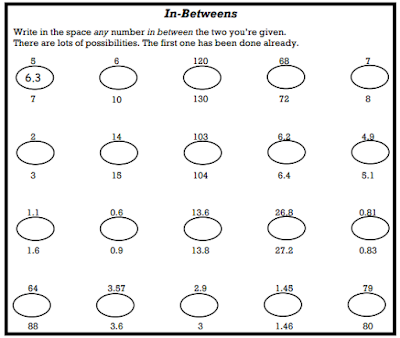1. In-Betweens from Colin Foster
This is an enjoyable and highly accessible activity with a good stretch task. It will start to give you a good idea of how much your new Year 7s know about place value.
2. Rainbow Squares from Math Pickle
The idea is to find pairs of numbers that add up to square numbers (children were taught square numbers at Key Stage 2). There is a high level of challenge as the task progresses. If anyone struggles to get started here they could be given a list of square numbers.
In Gems 84 I wrote about the time I saw this classic activity in an interview lesson. It's really simple and engaging. It looks like it may have been based on this Nrich task.
Read this post to see a similar task in action.
4. Consecutive Chains from MathsPad
I love this - it's fun for everyone! Children first meet square and cube number in Year 5 and should be familiar with primes, factors and multiples. I think this task will be accessible to some Year 7s (perhaps after a reminder of number properties) but not all.
5. Shape Time Shape by Nrich
In this lovely task the coloured shapes stand for eleven of the numbers from 0 to 12. Each shape is a different number. Students have to work out which is which. This is an accessible and enjoyable task that gets students noticing and reasoning.
For an accessible introduction to tasks like this, check out the shape IQ puzzles here.
This pattern spotting task is slightly more challenging, but still accessible. This is good if you want your students to start secondary school with maths that looks quite different to anything they've done before.
There are loads more lesson activities in this set of numeracy activities from Colin Foster. I particularly like 'Musical Composers' and 'Number Triangles'.
7. Number Properties Challenge from Stephen Bodman
Give students three or four random digits and they have to generate numbers with specific properties - such as 'biggest number', 'smallest odd number', 'number closest to 3000' and so on. You can download the resource from TES and it could become a regular feature of your Year 7 maths lessons.
It's a good idea to quickly identify any students who don't know their times tables so you can provide them with support. Instead of giving them a times tables test, you could ask them to complete some Find the Factors puzzles. These multiplication based logic puzzles are fantastic. Students are given a standard multiplication grid with only a few numbers completed, and they use their knowledge of times tables to deduce the numbers around the outside. Then they can complete the rest of the grid. The difficulty levels vary from super simple to very challenging.


9. Various Puzzles
There are numerous puzzles that involve logic and arithmetic and are suitable, and enjoyable, for Year 7s. They include Yohaku puzzles which test number sense and problem solving skills, and KenKen puzzles which help develop arithmetic fluency and reasoning skills. Other good sources of activities include Searches and Crossums from Frank Tapson, Magic Squares from Don Steward, and this page of puzzles which features Tenner Grids, Fubuki, Shape Boxes and lots more.
********
All secondary teachers, but particularly Year 7 teachers, should know the content of the primary maths curriculum. This summary by Michael Tidd is very helpful, and perhaps worth looking at during a maths department meeting at the start of the new school year. It's also a good idea to look through the SATs papers that your new Year 7s took at the end of Year 6. To help you translate their SATs scaled score data - in 2018, a mark of 61 out of 110 (i.e. 55%) translated to a scaled score of 100, which is the Government's 'expected standard' pass mark. Of course the numbers don't tell us much, so hopefully our students will start to show us much of their mathematical knowledge and understanding over the first few weeks of Year 7. We must give them the opportunity to do so!








I can't tell you how many times you've posted a set of resources which are exactly what I need for the following week :D Also a great reminder of the awesome Colin Foster's activities. Thanks for all the hard work you put in - it's very much appreciated!
ReplyDeleteThank you! I'm so pleased it's helpful.
DeleteThank you :-)
ReplyDeleteThank you.
ReplyDeleteThese are great! The link to the number mazes task appears to be broken however. Any idea where I could find an alternative copy of these?
ReplyDeleteHi. Frustratingly, it looks like all of Erich Friedman's puzzles have now been removed from the Stetson website, so I will remove this activity from the blog post. But if you still want to use them, I did download some (but not all) last year: https://drive.google.com/file/d/1mV1s6550uQacr1IMqRMLeM5_F2Btw9xm/view?usp=sharing
DeleteHi Jo! Just FYI, Erich Friedman's puzzles are now available again at his github site: https://erich-friedman.github.io/ Also, for future cases of dead links, it's worth knowing about the Wayback Machine at the internet archive: https://archive.org/ You can find snapshots of websites in their past forms there, even after links go broken.
DeleteIf you would like something a bit different for Year 7 to consolidate multiplication why not check out my workshop on the slide rule presented at #mathsconf26 (at 13:56mins to 23:31mins). https://completemaths.com/mathsconf/26. They'll learn something about the slide rule and practise multiplication at the same time. Does require them to be able to fold paper in half accurately! I know you love the slide rule. Thank you for another great Gems post. Jenny
ReplyDelete